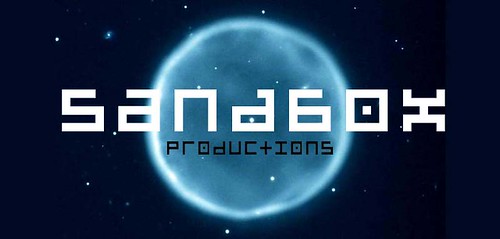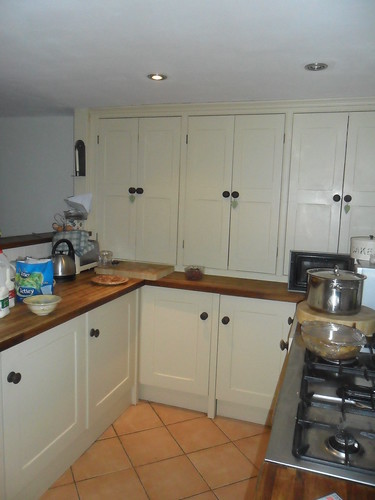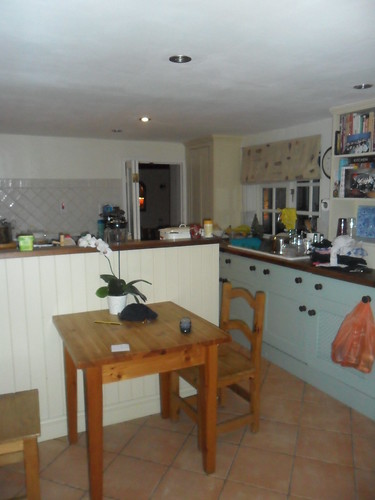The film i have choosen to write my essay about is called BlackOut, it is a claustrophobic thriller about a group of individuals who become stuck in a lift during a holiday weekend in their apartment block, in the small space the 3 people become agitated and their tempers start to fray.
The opening titles are very edgy as they use the same sort of effect that we have choosen for our media project opening titles, the flickering titles give the effect that something is not quite right. As the actual film comes into view we can see an old house, the furniture in the house is very old fashioned at first and gives us the feel that there is something mysterious about the house. Next the cmaera begins the pan across the room which is still giving the same effect as the intital shot, the house seems very old and the slow panning gives the viewer an eerie feel. As the camera is panning round the room you can hear the dripping of a tap or shower, this noise is very creepy as we later find out in the pan that the dripping is infact the dripping of the blood onto the floor, behind the hand coming out of the bath we can see a man, although we can not make out what he looks like as the shot is focusing on the hand and arm coming out of the bath. At first we think that the man sitting in the background of the shot has murdered the girl in the bath, but the next shot of the man is when he is sitting in the background and the arm is once again in the foreground which could once again make us think that the man is looking over the work he has done however the shot moves from focusing on the arm to actually focusing on his face, that seems striken with grief. This could tell us that he has either come in the bathroom to find the girl with the slit wrist or he has fully realise what he has done and is now coming to terms with his actions. The man starts to "narrate" his thoughts on what he has lost, however we can not fully trust him as he may be an unreliable narrator because things are coming from his side. His eyes aren't looking at the slit on the girls wrist but he is infact looking at the girls face, showing that he has a connection with the victim because he doesn't care about the slit he only cares about the look on the girls face and her eyes.
Monday, 28 February 2011
Friday, 18 February 2011
Our Thriller Poster
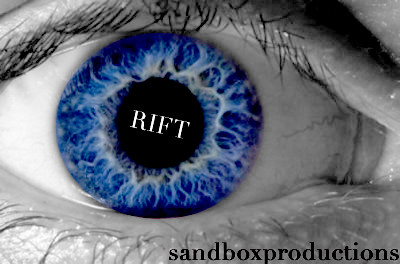
We used photoshop to create this image. We copied the eye in colour into a black and white layer of the whole image and added text. We used the image of the eye as it is significant in our film about seeing the future, and is a traditional thriller convention.
Production Logo Ideas
We have chosen Sandbox to be the name of our production company. We decided to create a futuristic logo for Sandbox Productions, and decided to keep the image somewhat generic to allow a variety of different films to be produced by the company in the future, without limiting it to a certain genre.
The programme used to develop the image was Adobe Photoshop, and we found the images online and the text on an online text generator.
The programme used to develop the image was Adobe Photoshop, and we found the images online and the text on an online text generator.
Titles Practice
This is our Titles practice. We used the font 'Didot' and the effects of earthquake and strobe. We feel these effects fit in with the name of our thriller film 'Rift'.
The section after the initial title was added in a quick attempt to show what the in-movie titles will look like, obviously having the text over a moving image in the final production.
Thursday, 17 February 2011
Location Recce
Location Recce - Kitchen
Here are some images of my kitchen which could potentionally be used a the film set for the kitchen scene in our thriller "Rift" the ideal scene in our head would be to see the character doing his morning routine but having extreme close ups of mundane things such as the kettle boiling, stirring the tea and buttering the bread, my kitchen has a seating area in which the main character in our film could potentionally pick up his newspaper to reveal the shocking news about the car crash. The kitchen is very bright as there are two large windows plus a conservatory next to it meaning there could possibly be alot of natural lighting or we could use the blinds and close the doors and provide our own synthentic lighting to get the feeling of an early morning. I have taken 4 shots of my kitchen, one being in each corner of the room to get a real feel for the space.
Titles Practice
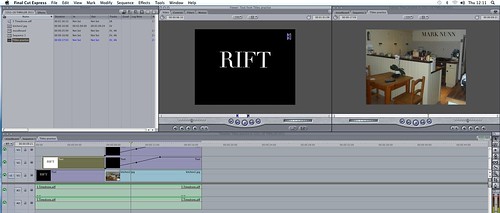
This is a screen shot of the titles we have been practicing for our thriller film project in Final Cut. We used the Text tool to create our titles and then added the effects of 'Earthquake' and 'Strobe'. The image of the kitchen is the kitchen we will use in our final project.
Tuesday, 15 February 2011
Potential area to take pictures of the accident
Below are some pictures of the street right outside my house. Below are some reasons as to why this street is ideal to film on.
- Apart from the houses further up the road, there is only one access route to the road to ensure the area is safe at all times. We can easily have one person just keeping an eye out for the odd car wishing to pass.
- The road is wide, meaning this road can be indistinguishable between a busy inner-city street and this.
- Minimal distraction - there are very few people that travel up and down the road so that means there will be barely any onlookers or distractions.
Potential area for the kitchen scene
Below are some pictures of my kitchen. I believe this kitchen is a potential area to film due to the correct props in the scene and can have harsh lighting, should it be required.
Test shots of the 360 degree spin
Below are two potential ways in which we could choose to film the 360 degree shot signalling the start of the vision, either using a dolly or handheld.
Using a Dolly
When we used a dolly, we received varied results. The overall consensus is that the dolly made the filming really smooth on the surface we chose to film on. However, any bump on the surface, created a noticable jolt in the filming process. We also cannot gaurantee that the surface that we choose to film on in Cambridge will be perfectly smooth like the one we chose in the college grounds. The final issue of using the dolly is the sound made by the wheels on the ground. This is only a minor issue because we will be planning to have a soundtrack playing over the filming.
Filming without a dolly
We decided that filming without a dolly was much easier than filming with one. We decided this for many reasons, first of all, if the cameraman/woman uses a steady hand, then the filming can still be very stable and have minimal jolts. Filming without a dolly also eliminates any problems associated with the street surface, seeing as it is easier to alter the position of the camera in your hands opposed to changing the height and position of the camera whilst attached to the dolly. The section of the clip where the camera must zoom in on the character's eye is also much easier when handheld seeing as the camera user can literally move the camera towards the actor and zoom at will.
Font Ideas for our Titles
Font idea for the title 'Rift':

We like the look of this font for our title because the effect is very thriller-like. The jerky letters link to a 'rift' in the font, just like a rift in time and space in our opening.

We also like this font as the breaks and cuts in the letters also link to our title. It gives a hint to what is to come.

Another font is this one - all the fonts we are interested in using have breaks and cuts in the letters, linking to our title.

This is the fourth font we are considering for our thriller opening title. It has a broken effect like the others but the boldness compared to the white gaps really stands out and sets it apart from the other fonts.

We like the look of this font for our title because the effect is very thriller-like. The jerky letters link to a 'rift' in the font, just like a rift in time and space in our opening.

We also like this font as the breaks and cuts in the letters also link to our title. It gives a hint to what is to come.

Another font is this one - all the fonts we are interested in using have breaks and cuts in the letters, linking to our title.

This is the fourth font we are considering for our thriller opening title. It has a broken effect like the others but the boldness compared to the white gaps really stands out and sets it apart from the other fonts.
Props & Costume
The costume for our protagonist - the only character you see in our opening - is a black business suit and a black briefcase. This represents his job and portrays him as a normal every day businessman. This fits in with the thriller convention of extraordinary things happening in an ordinary environment.
The props we need include:
- briefcase - for our main character
- broken glass/plastic, fake blood - for the car crash images
- newspaper - for the kitchen scene
- cup of tea/spoon, plate/knife/butter - for the kitchen scene

The props we need include:
- briefcase - for our main character
- broken glass/plastic, fake blood - for the car crash images
- newspaper - for the kitchen scene
- cup of tea/spoon, plate/knife/butter - for the kitchen scene

Friday, 11 February 2011
Sonic Moodboard
This is our sonic mood board that includes pictures that we are going to use in our final film. We used final cut to create our mood board and added in the 'Time drone' sound to create a tense atmosphere, which is the atmosphere we would like to use in our opening.
Tuesday, 8 February 2011
Example of diegetic sound shown in kitchen scene
http://www.youtube.com/watch?v=0Vya2O-GePc&playnext=1&list=PL90672D0555CFC46E
This clip from Shaun Of The Dead is an example of the types of shot we are hoping to have in our Thriller Opening. We are hoping to film longer, slower versions of the tea stirring (at ) and of the toast spreading (at ).
We wish to use different versions of the tea scene (With slower stirring - In a more tired manner) and the toast (With more tired spreading and cutting) clips.
This clip from Shaun Of The Dead is an example of the types of shot we are hoping to have in our Thriller Opening. We are hoping to film longer, slower versions of the tea stirring (at ) and of the toast spreading (at ).
We wish to use different versions of the tea scene (With slower stirring - In a more tired manner) and the toast (With more tired spreading and cutting) clips.
Monday, 7 February 2011
Children's Film Analysis
We could have improved our childrens film in a few ways, here are three ways in which we could of improved it -
- Plan - We didn't succesfully plan our media project so therefore we wasted too much time on the preparation of our set and props instead of planning our script and camera shots.
- Script/Shot List - We didn't set up a proper shot list which would have allowed us to know what shots we were doing as we were filming, also we hadn't prepared a script therefore we didn't know what our characters would say.
- Sound - We didn't really try to make our sound fit in with our childrens film because we spent too long editing the film and didn't have time to correctly choose the soundtrack for our childrens film.
Improvements On Children's Film
- Planning - We came up with an idea and how to film it, but we left our mise en scene until last minute which resulted in less time to film.
- Editing - Basic editing was used, to make our children's film fit into its genre we could of used a variety of editing techniques to meet the conventions of children's films.
- Angles/Shots - This was also more basic, after seeing other groups children's film openings I saw that we could of used more angles/shots to make it more appealing for the audience.
Why Thrillers Thrive
Why Thrillers Thrive
I think that the main points made by this article are telling us that a thriller is a different from most other types of film, because of the sense of “danger” we are putting ourselves in seems great however in our subconscious we know that we are fine. It also talks about how a thriller is different to other films, they allow the viewer to think more about what they are watching, instead of going to the cinema and seeing a romantic film where they know what the plot will be whereas when they watch a thriller they will think up numerous plots yet none of them will be correct because thrillers are the most diverse genre. They can do what you expect but have a twist at the end or they can have a twist at the beginning leading to a bigger twist at the end.
A thriller gives you thrills but not the kind that leave you fearing for you life, like the sideshow the news article talks about, this is a different kind of thrill, a thrill that people didn't like because it made them feel vulnerable, whereas a thriller you will always be safe even if you feel like the antagonist is standing over you and breathing down your neck.
It is quite amazing how this article is from the 1930's yet you can read it like it was written today, this is because it is talking about thrillers and thrillers will always stay the same yet they will always be so enjoyable, whereas other films move with the times and they change.
Children's Film Analysis
Three things we could improve upon from our children's film are:
1. Camerawork - we did not include a variety of shots, angles or movements in our opening which would have made viewing a lot more interesting for the viewer. We should have used a shot list to plan our camerawork more carefully.
2. The script - we did not write or rehearse the script ahead of time, so it was quite poor.
3. Sound - we focused so much on the mise en scene of our film that the sound suffered and the music did not fit in well with the plot.
1. Camerawork - we did not include a variety of shots, angles or movements in our opening which would have made viewing a lot more interesting for the viewer. We should have used a shot list to plan our camerawork more carefully.
2. The script - we did not write or rehearse the script ahead of time, so it was quite poor.
3. Sound - we focused so much on the mise en scene of our film that the sound suffered and the music did not fit in well with the plot.
Thursday, 3 February 2011
Risk Assessment
With filming, it is critical that every aspect is risk assessed in order to ensure saftey as a group, so that no-one gets in trouble or in danger of being hurt or worse.
Below is a list of all of the things that could prove a potential hazard to the group and with the risk assessment we will hope to avoid all the dangers in filming:
- Filming on/near the road
The road can be very dangerous, especially in the peak times that we will be expecting to film. the main hazard is obviously walking out in front of a car. The way we will hope to avoid danger near the road is to simply be careful and make sure that there is always one person watching the traffic and making sure that the group don't stray too close.
2. Filming in the road
For one scene of our film, we will be required to film laying down in a road for the crash sequence, this will require great safety as we would not be able to close the street itself because it is clearly a public place. The way in which we wish to solve this problem is by filming the scene on a quiet street near one of our homes, a road well known to the members, and outside peak traffic times. We will be looking at numerous locations to film the scene to find the best place.
3. Dangerous props
We don't have many dangerous props in our opening, however, a few of the objects could be dangerous if we are not careful - items such as hot tea, broken glass and the knife used to cut the toast and spread the butter. Most of these can be avoided so we will just need to be careful.
We don't have many dangerous props in our opening, however, a few of the objects could be dangerous if we are not careful - items such as hot tea, broken glass and the knife used to cut the toast and spread the butter. Most of these can be avoided so we will just need to be careful.
Shot list
GENERAL SHOT LIST
The date 'February 7th, 2009' appears on the black screen.
Then, a man in a smart business suit is walking down a street in the morning [variety of shots: long shot, close ups of his face/suit, low/high angles, tracking movement], obviously on his way to work.
He freezes in the middle of walking, his face a picture of horror. A 360 degree pan around him adds to the surreal effect. with a zoom in to the man's right eye. [photographs - close ups of the crash]
He has seen a car crash, and photographs show parts of the crash such as broken glass and a crushed car.
The next scene, a flashback, shows the date 'February 20th, 2009' with the man sitting in his kitchen in the morning [long shots, close ups of his face and actions], buttering his toast and drinking his tea, reading a newspaper of that exact crash he sees in the next few weeks [close ups on newspaper's words such as crash, dead].
SPECIFIC SHOT LIST
Location: Street
Shot 1: (Present) Long shot of the front of the man walking, establishing shot
Shot 2: (Present) Close up of his hand holding his briefcase
Shot 3: (Present) Close up of his face
Shot 4: (Present) Long shot from behind him, showing him walking
Shot 5: (Present) Medium close up of his feet walking
Shot 6: (Present) Close up on his face, horrified
Shots 7-25: (Present) 360 degree around him
Shot 26: (Into man's mind) Zoom in on his eye
Shots 27-34:(Man's vision): Photographs of the crash
Shot 35: (Present) Medium close up, the man drops his suitcase in shock
Shot 36: (Present) Long shot on the man reading a newspaper in his kitchen
Shot 37: (Present) Close up on man's eyes scanning the news
Shots 37-40: (Present) Close ups on him stirring his tea, buttering his toast
Shot 41: (Present) Medium close up as he picks up his newspaper
Shot 42: (Present) Close up on his eyes reading his newspaper and the shock that registers when he reads about the fatal crash
Shot 43: (Present) Close up & photographs of the newspaper article
Shot 44: (Present) Medium close up on the man looking shocked
Title
The date 'February 7th, 2009' appears on the black screen.
Then, a man in a smart business suit is walking down a street in the morning [variety of shots: long shot, close ups of his face/suit, low/high angles, tracking movement], obviously on his way to work.
He freezes in the middle of walking, his face a picture of horror. A 360 degree pan around him adds to the surreal effect. with a zoom in to the man's right eye. [photographs - close ups of the crash]
He has seen a car crash, and photographs show parts of the crash such as broken glass and a crushed car.
The next scene, a flashback, shows the date 'February 20th, 2009' with the man sitting in his kitchen in the morning [long shots, close ups of his face and actions], buttering his toast and drinking his tea, reading a newspaper of that exact crash he sees in the next few weeks [close ups on newspaper's words such as crash, dead].
SPECIFIC SHOT LIST
Location: Street
Shot 1: (Present) Long shot of the front of the man walking, establishing shot
Shot 2: (Present) Close up of his hand holding his briefcase
Shot 3: (Present) Close up of his face
Shot 4: (Present) Long shot from behind him, showing him walking
Shot 5: (Present) Medium close up of his feet walking
Shot 6: (Present) Close up on his face, horrified
Shots 7-25: (Present) 360 degree around him
Shot 26: (Into man's mind) Zoom in on his eye
Shots 27-34:(Man's vision): Photographs of the crash
Shot 35: (Present) Medium close up, the man drops his suitcase in shock
Shot 36: (Present) Long shot on the man reading a newspaper in his kitchen
Shot 37: (Present) Close up on man's eyes scanning the news
Shots 37-40: (Present) Close ups on him stirring his tea, buttering his toast
Shot 41: (Present) Medium close up as he picks up his newspaper
Shot 42: (Present) Close up on his eyes reading his newspaper and the shock that registers when he reads about the fatal crash
Shot 43: (Present) Close up & photographs of the newspaper article
Shot 44: (Present) Medium close up on the man looking shocked
Title
Wednesday, 2 February 2011
Why "Thrillers" Thrive
The article about why thrillers thrive was really intriguing. It revealed that human nature needs 'thrills' in our life to feel fufilled, but, because of our 'sheltered civilisation', we must experience them second-hand, through the cinema. When a thriller is well-made, the audience do not just watch, they participate, so they leave the cinema feeling like they have really experienced the events themselves, with a 'subconscious assurance of absolute safety'. Horrors, in contrast, can leave the audience feeling unsafe and can cross 'the line between horrific and horrible', horrible being unacceptable in the public's 'healthy mind', and because thrillers are about what you don't see, not what you see, this is why they will 'thrive' in the cinema.
Tuesday, 1 February 2011
After watching Amir's presentation on Planning and Shooting, these are the three main points we learnt:
- Do some research on the location
We were told, in the presentation, that one of the most important things that a group can do is research the area that the filming will be taking place in.
This is important because there are problems that can arise that the group cannot forsee, but if the group is well planned and scouts out the area first, the group can avoid these dangers/problems.
Some of these problems involved can be:
- Outside noise, such as traffic sounds and the public.
- Certain time restrictions such as shop openings and closing, and rush hour crowds etc.
The way in which we will overcome this, is by visiting the location of the filming before the final filming date and doing a location recce.
2. Digital Storyboard
We were told in the presentation that we should take photographical evidence of the locations for our film, we should take different angles, frames and shot types and then print them off as a reference for filming. We could then map out our filming route onto google maps and this would allow us to know where we would walk and do our filming. If we were going to use a Close Up shot then we could try taking a Wide Shot aswell to see which shot we preferred once we got back to our planning stage.
3. Storyboard
I believe the most important phase of the planning, is the storyboard. I think the storyboard is easily the most important aspect to the planning for the simple reason that on the sheet, you can see every important feature of the scene, such as camera angles, positioning etc.
Script
Rift
The date 'February 7th, 2009' appears on the black screen. Then, a man in a smart business suit is walking down a street in the morning, obviously on his way to work. The shots then become photographs as he freezes in the middle of walking, his face a picture of horror. He has seen a car crash, and photographs show parts of the crash such as broken glass and a crushed car. The next scene, a flashback, shows the date 'January 20th, 2009' with the man sitting in his kitchen in the morning, eating breakfast and drinking his tea, reading a newspaper of that exact crash he sees in the next few weeks.
Above is a brief explaination of the plot of our Thriller opening, we will be sure to include a more detailed script and storyboard on the blog page.
The date 'February 7th, 2009' appears on the black screen. Then, a man in a smart business suit is walking down a street in the morning, obviously on his way to work. The shots then become photographs as he freezes in the middle of walking, his face a picture of horror. He has seen a car crash, and photographs show parts of the crash such as broken glass and a crushed car. The next scene, a flashback, shows the date 'January 20th, 2009' with the man sitting in his kitchen in the morning, eating breakfast and drinking his tea, reading a newspaper of that exact crash he sees in the next few weeks.
Above is a brief explaination of the plot of our Thriller opening, we will be sure to include a more detailed script and storyboard on the blog page.
Inspiration
 Donnie Brasco
Donnie BrascoDonnie Brasco Opening
The idea of using photographs to establish the story came from the thriller 'Donnie Brasco'.
'Donnie Brasco' uses photographs to create an almost moving image, yet the image focuses more on the details of the shot, which is what we want for our opening.
The transitions between the images in 'Donnie Brasco' are smooth, making the film visually pleasing to the viewer.
Subscribe to:
Comments (Atom)
